
You have been hired to accompany some auditions. All day long, diverse instrumentalists and singers have been turning up with various music, in various states of preparation, for you to sight read. At the very end of the day, a singer arrives and hands you a sheaf of loose crumpled pages. They contain an aria by Richard Strauss—that is to say, most of an aria by Strauss. It's a third generation photocopy, with three generations of pencil markings. The first person who tried to photocopy it wasn't entirely successful: all the clefs and key signatures are missing, as well as, on the last system of each page, any bass note lower than E. A previous accompanist has helpfully pencilled in "crotchet=160" at the top of the first page. You take a deep breath and play the first two bars as quickly as possible—and the singer comes in a beat early, and quite a lot faster. How can you make the best of this situation?
Contrast this with the best case scenario. The telephone rings in late January. It's a student who has just enrolled in an honours degree. They will have their graduation recital in November. They've met their teacher and chosen some repertoire, and now they want to have a weekly rehearsal with an accompanist. You have plenty of time to study their concerto from the full orchestral score, listen to a lot of different recordings, spend dozens of hours practising the piece, and rewrite the piano part to suit yourself. Although it's far removed from "traditional" piano playing, it can be an immensely rewarding experience to master an orchestral reduction in this way.
However, in this paper we will be focussing mostly on basic survival tactics. What are your first impressions when a score is put in front of you?
The first principle is to simplify. In our worst-case scenario, you shouldn't even try to play all the notes on the page. Of course this is easier said than done, and it's possible to try silly things in the heat of the moment. So most of all I want to look at the different contexts in which you might or might not decide to simplify something, and find some bases for making these judgements.
The second level of survival tactics is rhythmic clarity. Once you've chosen which notes to play, how do you make it bullet-proof? What are the techniques you can use to hold the ensemble together in difficult situations?
Our third main topic, instrumentation, moves beyond the level of basic survival. If you do have the luxury of studying a score at leisure, how can you add colour to arrangements that can sometimes be bland? There's no need to go overboard: sometimes just adding one note in the right place can change the texture of a whole passage.
Let's begin with Mozart.
Our first example is from Mozart's A major violin concerto.

If you haven't seen it before, this can come as an unpleasant shock, since the opening tutti of this piece usually fits on a double page, and looks quite playable. And then you turn the page and see this a row of double thirds in demisemiquavers. And it should sound very smooth:
In ideal conditions, it is actually possible to play all the notes (it's not quite as bad as it first looks)—but it depends on knowing that the violinist won't take off too fast, and it depends a bit on having a piano in good condition.
In an audition situation it's a different story. If you haven't prepared this passage, and you decide to have a go at playing all the notes anyway, the result is liable to be too loud, "clunky" (not at all legato), and can generally ruin the atmosphere that the violinist is trying to create.
This sort of thing can be a battle with your own ego. Of course you want to show how good your piano technique is, and too much pride can land you with an impossible job. In auditions and rehearsals you're not being judged; you just have to set the scene with the minimum amount of fuss.
In this case there's a very simple solution: just play the top notes of the thirds. Playing a single line melody means that it's easy to make it as quiet and smooth as you want.
Here's another example in a similar spirit.

This is from Orff's Carmina Burana. The choir is about to sing (in mediaeval German) "If I owned the whole world..." and the piece begins with this grand fanfare .
Of course it's easy for brass players to double-tongue the repeated notes, but it's quite a different matter on the piano. Here, if you decide to try and play all the notes, it's liable to come out too slow.
There are two standard ways of facilitating this type of passage.
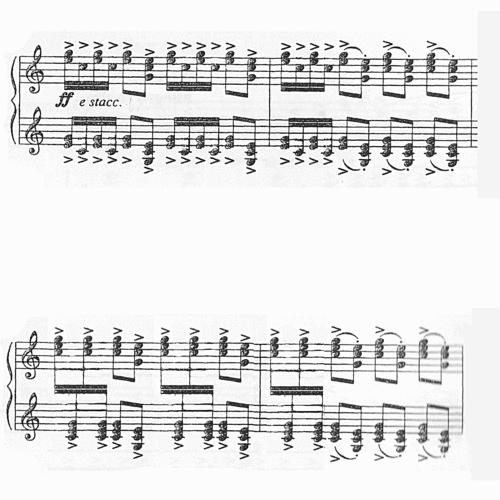
Maybe it's not as spectacular as playing all the repeated chords, but you can get the right energy level at the right tempo without killing yourself, and that's more important than a literal interpretation of the notes. Remember that in a rehearsal, you might have to play it ten times in a row.
The third system of the same piece provides another technical problem for the pianist: playing the octave Gs in the left hand results in a very awkward crossed hands position. Just play the bottom notes of the octaves and leave out the top: most people can't hear the difference!
Now we move on to the second case, where even if you do have time to practice and learn all the notes, you wouldn't want to play them anyway.
The most striking example I can think of is from the Bartók viola concerto.

From the piano part, this looks totally unintelligible. However, what's happening in the orchestra is actually quite logical.
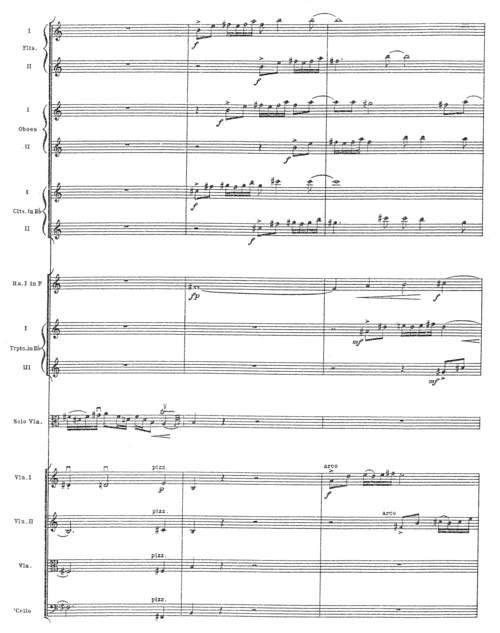
What to do on the piano? Well, the principal motif needs to be clear, and you want to get across the idea that it's a canon of some sort. Solution: play just every second entry!
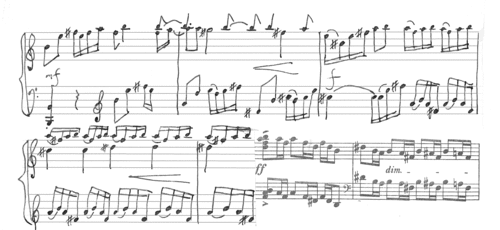
The third case is where you may or may not simplify something, according to the conditions on the day. Consider this passage from Chaminade's Concertino for flute and orchestra.
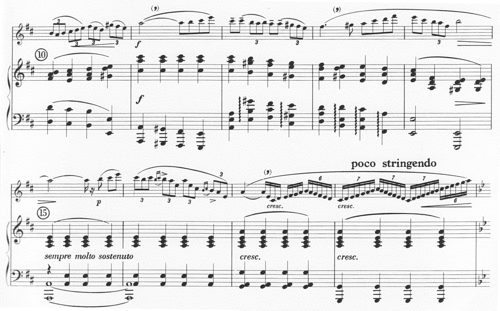
Now, when I play orchestral reductions, of course I like to imagine that I'm an orchestra—and an orchestra makes a big, full, rich sound. If you're accompanying the sort of flute player who'd be at home standing centre stage in the Festival Theatre with a full orchestra behind them, then this sound is just great.
However, it's more likely that you'll be accompanying a nervous first year student who's not quite ready for their exam. In that case you need to be conscious of how difficult it is for them to make a good sound on a low C sharp, and you need to be ready to leave out notes and thin out the sound.
Case 1: pragmatic simplification: Here the passage is playable in ideal conditions, but the reality of the accompanist's professional life is that conditions are rarely ideal. It's important to have the courage of your convictions: simplifying in these conditions isn't a sign of weakness or laziness, it's an important survival tactic.
Case 2: essential simplification: Here the passage won't work even under the most ideal conditions. Given time you'll rewrite it (possibly by photocopying the page and whiting out most of the notes!); sometimes you have to be able to simplify these things "on the run" as they come up.
Case 3: situational simplification: Here the passage is playable as written and can sound good in the right context—but you need to be ready to adjust to the situation (who you're accompanying, what the piano is like, the acoustics of the venue, et cetera).
When I was first learning how to accompany, my most common mistake was to follow people too much. Of course you should always listen, but that's not the same thing. Sometimes the best thing an accompanist can do is to provide a clear framework. Let's see how it works.

This is from the Introduction and rondo capriccioso of Saint-Saëns . A row of repeated A minor chords on the piano: what could be simpler?
Well, there's a change of tempo, the violin has some slightly tricky ornaments, the rhythm of the solo part is very syncopated (trying playing the solo melody together with the bass on the piano) and there's some tricky passages ahead. It's easy for a violinist to feel insecure about the tempo here (especially if it's one of those nervous underprepared students). It's easy for them to take off too fast—and if the accompanist "helpfully" follows, then there will be a train wreck on the next page.
This is the place where you need to dig in your heels, play the chords in an absolutely rigid tempo, and listen carefully to what happens. The first two bars probably won't be together: but within four to eight bars, it should be clear whether the violinist is just wobbling accidentally, or whether they definitely want a different tempo—and then you follow them.
Let's see a more elaborate example of the same thing, from near the end of act 1 of Die Walküre.

After exchanging smouldering glances for forty minutes, Sieglinde finally decides she wants to be with Siegmund and damn the consequences. The music rushes forwards headlong, and it's easy for the singers to lose their way at this point.
On the piano, this passage can turn into an impenetrable thicket of
notes. But, underpinning the Wagnerian lushness is a very simple
structure. Notice the chromatically rising bass:
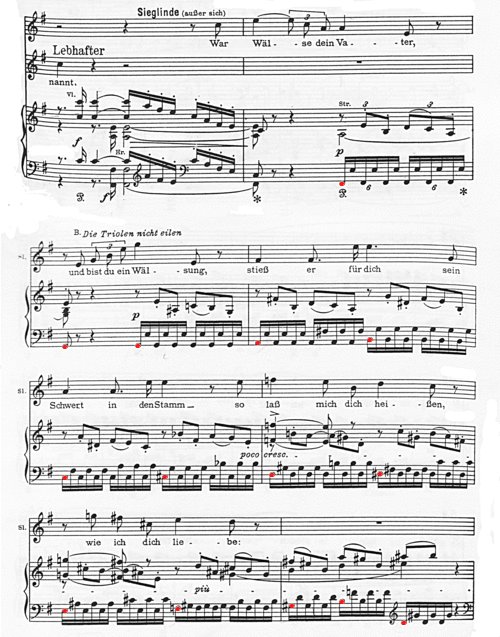
If you needed to simplify this passage, you'd play single bass notes and leave out the tremolos. But even if you can play all the notes, you can still help the singers immensely by emphasising this structure.
Often the key with this type of passage is to emphasise the left hand at the expense of the right—the opposite of what a well trained solo pianist will do instinctively!
Our final example for this section shows off a useful "trick of the trade". Orchestral reductions often contain devices such as broken chords, grace notes and tremolos which add to the richness of the texture—but they can also obscure the rhythmic pulse. So if you're working under stressful situations, it can be best to compromise on these elements.
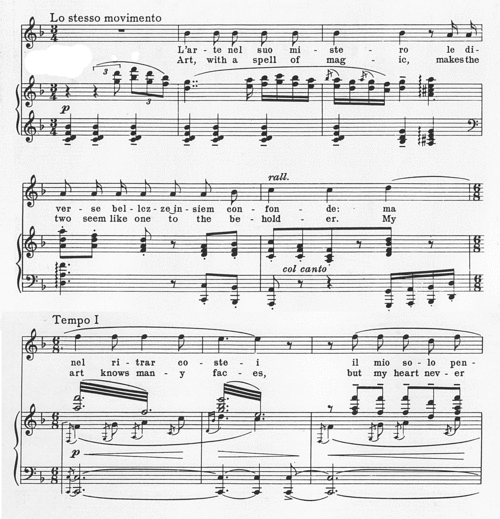
This is near the end of Recondite armonia from Tosca.
Observe the tempo change coming into the third system, and note the grace note in the bass. What the arranger really wants is for all three staves to sound simultaneously, but for most two-armed pianists it's impossible. The 19th century tradition is to slip in the bass as a grace note before the beat, which works fine in solo piano repertoire, but see what it does to the melody line here (demonstrate as written). It's as if the orchestra suddenly hiccups: not what the singer needs near the end of a long phrase.
The solution is to play the grace note on the beat and start the tremolo late (demonstrate). There are many situations where grace notes can be handled this way.
Of course the ideal when playing orchestral reductions is to imagine the sounds of all the different instruments. Sometimes the arranger has helpfully written them in; sometimes you can remember from having heard the piece; sometimes you need to find the full score and look it up.
You might imagine that romantic pieces, with their lush orchestration, pose the biggest problems here. Actually the opposite is true: the romantic styles of orchestration and of virtuoso pianism, with their broad sweep, are good matches for each other. It's good old Mozart who, very simply, asks us the difficult questions. Let's have a look at The Marriage of Figaro:

Here is the end of Non più andrai.
What are the two most neglected instruments in orchestral reductions?
If you open an orchestral score, it's usually obvious that the strings do most of the work; and you have the woodwinds right at the top of the page. Therefore arrangers tend to concentrate on the string and wind parts. Here we have what looks like a dialogue between strings and brass.
But notice on the recording that in this bar, there is a third
element.

And with the timpani part included, it's easier to play too! The left hand just has to repeat one note.
And the other commonly missing instrument?
Later in the same opera, this example is from
Voi che sapete.

Here Mozart manages the extraordinary feat, with the natural horns of the time, of modulating through several keys while getting the horns to play in nine out of eleven bars. I'm sure he was very proud of this touch of colour, yet it is missing from most piano arrangements.
Unfortunately it's almost physically impossible to fit the horn part in on the piano throughout most of this passage. But in the second through fourth bars of the last system, it's quite easy for the left hand to hold down an E flat while playing the bass notes (to do: make a picture with the extra note added.) Notice how adding just a single note in the right place can change the whole texture: what could be a monotonous piano part acquires a new dimension.
So far we've looked at three categories of simplification; seen a few examples of how to increase the rhythmic clarity of a passage; and had a brief look at the role of instrumentation.
There are many other aspects of orchestral reductions that deserve further attention. Staccati can be treacherous. Is it wind or strings? bowed or pizzicato? There are many tricks for dealing with tremolos, rewriting complex passages, and different types of pedalling and voicing that can add clarity and colour to your playing.
I hope that this brief introduction has at least brought into focus
some basic survival skills and given you food for thought.
If you have any questions, comments or suggestions, please let me know!
Posted 29th May 2008; some small corrections made 6th July 2010; new and improved version still to come!